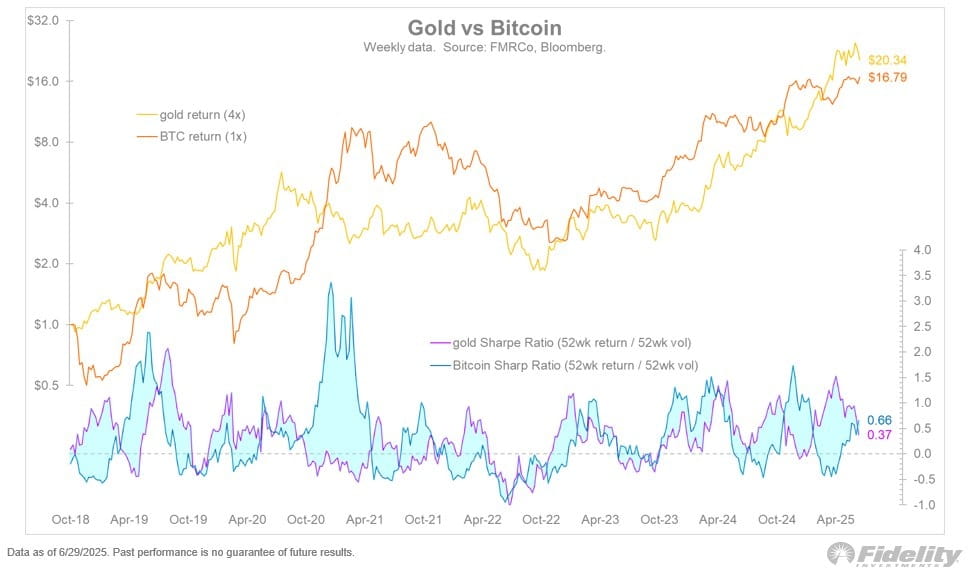The parabolic rise of Bitcoin could last until Christmas, with a cycle peak near $300,000, according to an analyst.

Key takeaways:
Bitcoin is ahead of its long-term 'power law' curve, which has historically led to euphoric price peaks in previous cycles.
The decline of the dollar and anticipated interest rate cuts from the Federal Reserve could trigger a broader rally in risk assets, with Bitcoin as one of the main beneficiaries.
Spot Bitcoin ETFs have captured 70% of gold inflows in 2025.
Bitcoin $BTC
has surged 10% in July, reaching new highs of $118,600, and this could just be the beginning of a parabolic rally, according to the anonymous Bitcoin analyst apsk32. The analyst said Bitcoin could be worth up to $258,000 if history repeats itself.
According to apsk32, Bitcoin's price action has followed a long-term power curve trend line, a mathematical model that reflects the exponential growth of BTC over time. It measures the deviation of the price from this trend line, not only in terms of dollars but in units of time, an approach known as Power Law Time Contours.

The analystexplainedthat Bitcoin is a little over two years ahead of its power curve, meaning that if the price were to remain flat, it would take more than two years for the long-term trend line to intersect it again. Apsk32 said,
"We are currently above 79% of historical data using this metric. The top 20% is what I call 'extreme greed.' These are the explosive peaks that occur approximately every four years."
The 'extreme greed' zone ranges from $112,000 to $258,000, a range seen during Bitcoin's euphoric peaks in 2013, 2017, and 2021. The analyst hinted that 'if the four-year pattern continues,' Bitcoin could be between $200,000 and $300,000 by Christmas, before the bullish momentum begins to fade in early 2026.
Additionally, Satraj Bambra, CEO of the perpetual trading platform Rails, told Cointelegraph that a couple of macroeconomic forces could significantly drive Bitcoin upward in 2025. Bambra pointed to an expanding Federal Reserve balance sheet and a shift towards lower interest rates, potentially under a new Fed direction responding to the economic slowdown from rising tariffs, as key catalysts. Together, these changes could ignite a widespread rally in risk assets, with Bitcoin poised to benefit.
Bambra cited the fall of the US Dollar Index (DXY) below 100 as a critical early signal of this macro shift, suggesting that a wave of rate cuts and new stimulus could soon follow. In this context, the CEO said,
"I see Bitcoin becoming parabolic in the $300,000–$500,000 range driven by two key forces."
The Bitcoin ETF catches up to gold as the risk asset rally builds
Spot Bitcoin exchange-traded funds (ETFs) are gaining ground against gold, capturing 70% of its net inflows this year, according to Ecoinometrics. This strong rebound from a slow start in 2025 signals growing institutional interest and confidence in Bitcoin as a legitimate store of value.
Bitcoin continues to be a risk asset, with a moderate correlation to the Nasdaq 100 over the last 12 months, consistent with its five-year average. Its low correlation with gold and bonds highlights its unique role in the portfolio.
Echoing that sentiment, Fidelity's Global Macro Director, Jurrien Timmer, recently commented that the baton has passed back to Bitcoin. According to Timmer, the narrowing gap in Sharpe ratios between Bitcoin and gold suggests that BTC is offering superior risk-adjusted returns. The Sharpe ratio measures how much excess return an asset provides for the level of risk taken, comparing its performance to a risk-free benchmark adjusted for volatility.
The chart below, based on weekly data from 2018 to July 2025, highlights how Bitcoin's (1x) returns have been approaching those of gold (4x). In terms of relative return, gold stands at $20.34, while Bitcoin has risen to $16.95.
